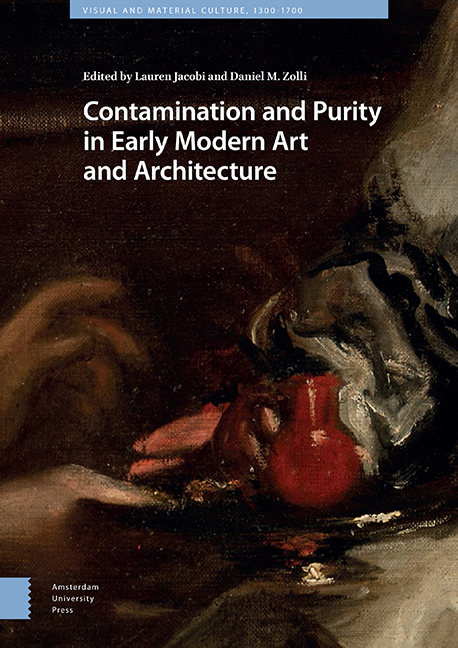Book contents
- Frontmatter
- Contents
- List of Illustrations
- Introduction: Contamination and Purity in Early Modern Art and Architecture
- 1 Generation and Ruination in the Display of Michelangelo’s Non-finito
- 2 The Sacrilege of Soot: Liturgical Decorum and the Black Madonna of Loreto
- 3 Sedimentary Aesthetics
- 4 ‘Adding to the Good Silver with Other Trickery’ : Purity and Contamination in Clement VII’s Emergency Currency
- 5 Tapestry as Tainted Medium: Charles V’s Conquest of Tunis
- 6 Bruegel’s Dirty Little Atoms
- 7 Leakage, Contagion, and Containment in Early Modern Venice
- 8 Contamination, Purification, Determinism: The Italian Pontine Marshes
- 9 Colonial Consecrations, Violent Reclamations, and Contested Spaces in the Spanish Americas
- 10 Contamination | Purification
- Index
7 - Leakage, Contagion, and Containment in Early Modern Venice
Published online by Cambridge University Press: 27 May 2021
- Frontmatter
- Contents
- List of Illustrations
- Introduction: Contamination and Purity in Early Modern Art and Architecture
- 1 Generation and Ruination in the Display of Michelangelo’s Non-finito
- 2 The Sacrilege of Soot: Liturgical Decorum and the Black Madonna of Loreto
- 3 Sedimentary Aesthetics
- 4 ‘Adding to the Good Silver with Other Trickery’ : Purity and Contamination in Clement VII’s Emergency Currency
- 5 Tapestry as Tainted Medium: Charles V’s Conquest of Tunis
- 6 Bruegel’s Dirty Little Atoms
- 7 Leakage, Contagion, and Containment in Early Modern Venice
- 8 Contamination, Purification, Determinism: The Italian Pontine Marshes
- 9 Colonial Consecrations, Violent Reclamations, and Contested Spaces in the Spanish Americas
- 10 Contamination | Purification
- Index
Summary
Abstract
Two well-known architectural types of enclosure in early modern Venice – the Jewish Ghetto and the plague hospitals or lazaretti – are examined within the spatial dynamics of quarantine and the larger geographic sphere of the Mediterranean. Architectural and urbanistic mechanisms for maintaining purity against influences the Christian Venetians understood as harmful, the ghetto and the lazaretto worked to visually recognize, bureaucratically identify, and physically seclude ‘dangerous’ individuals. Both were also porous: the ghetto was open to all during daytime hours, when Jews were also allowed to exit into the city, and the lazaretto's population grew and shrank as new people sickened and patients recovered or died. This ‘leakage’ broke through any ideal of containment, and could be productive, benign or malign.
Keywords: plague, Venice, Ghetto, Jews, quarantine, lazaretto
The ordinary practitioners of the city live ‘down below,’ below the thresholds at which visibility begins. They walk – an elementary form of this experience of the city; they are walkers, Wandermanner, whose bodies follow the thicks and thins of an urban ‘text’ they write about without being able to read it.
The French philosopher Michel de Certeau was an astute observer of cities and their inhabitants. His image is a compelling one: a city's walkers writing a urban text – or better still from my perspective as an art historian, painting a picture, step by step, stroke by stroke – of a city they cannot see. Yet, as even the most casual visitor to Venice knows, tracing out the thicks and thins of the Venetian urban landscape is a difficult task. The narrowest streets are sometimes major thoroughfares through the city; and, often one's path terminates in a dead-end or a watery canal. In Venice, walking in the city is always a fraught task. Indeed, this was purposefully so: Venice was, as the eleventh-century chronicler Giovanni Diacono put it, ‘not founded by shepherds as Rome was, but by rich and powerful people,’ who were fleeing rampaging Visigoths, Huns, Ostrogoths, and Longobards. The inhospitable swampy site had been expressly chosen over any placid open pasture for the very fact that it was difficult to reach and difficult to inhabit. Early modern writers on Venice such as Marco Antonio Sabellico and Giovanni Botero punctuated their descriptions of the urban fabric with repeated mention of the many bridges that might connect two islands – or could be blocked off.
- Type
- Chapter
- Information
- Contamination and Purity in Early Modern Art and Architecture , pp. 243 - 266Publisher: Amsterdam University PressPrint publication year: 2021

